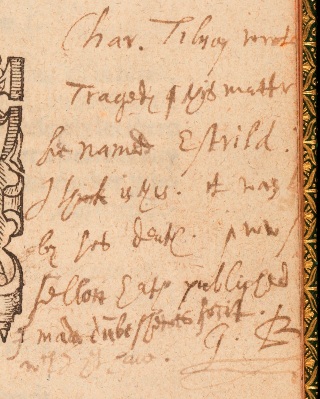Estrild
Charles Tilney (c. 1585)
Historical Records
Buc's note
An undated note in the hand of Sir George Buc on the title page of one of five surviving copies of Locrine (printed 1595) reads:
Char. Tilney wrote <a>
Tragedy of this mattr <wch>
hee named Estrild: <& wch>
J think is this. It was l<lost ?>
by his death. & now [?] s<ome ? >
fellow hath published <it.>
J made the dūbe shewes for it.
wch J yet have. G. B<.>.

|

|
Buc signature on the title page of Locrine; reproduced with permission from the Fondation Martin Bodmer, Cologny, Geneve.
Theatrical Provenance
Unknown; information welcome.
Probable Genre(s)
Tragedy
Possible Narrative and Dramatic Sources or Analogues
The story would have to be a pseudo-biography of Estrildis, daughter of the King of Germany, in the time of the war between Brute, first king of the Britons, versus Humber, King of the Huns, c. 1115-1075. B.C.E. According to Geoffrey of Monmouth, Estrildis was one of three captives aboard the ship of Humber, which held the spoil of Humber's recent conquests in Germany. Locrine, eldest son of Brute, defeated Humber in battle (Humber fled and drowned in the River Humber). Locrine then pillaged Humber's ships and claimed the girls. It was Estrildis who set him on fire, however: "so fair was she that scarce might any be found to compare with her for beauty, for no polished ivory, nor newly-fallen snow, nor no lilies could surpass the whiteness of her flesh" (Sacred Texts).
References to the Play
The only surviving reference to "Estrild" is Buc's note (See Historical Records.)
Critical Commentary
The context for discussion of "Estrild" by scholars is the anonymous play, Locrine, initially in regard to Buc's handwritten note on the title page of one copy of the 1595 printing of Locrine and subsequently in regard to its having been an analogue for, or early version of Locrine somehow revised into and absorbed by the author of the extant play.
Collier, in Catalogue of Early English Literature at Bridgewater House (1837), described the Buc note on the title page of Locrine (40-1); he added to that description in 1865 in Bibliographical Account of Early English Literature by providing a biographical blurb on Charles Tilney as well as asserting that "the authorship of "Locrine," false imputed to Shakespeare, is thus decided" (i.93-5, esp. 95).
Fleay knew of Buc's note, because he quotes Richard Simpson (without citation) as misattributing Locrine to Charles Tilney, whose name occurs in this matter only in the Buc note(BECD, 2.321))
Chambers
Greg, in the context of examining three manuscript notes by Sir George Buc, reviewed the contributions of John Payne Collier to scholarly awareness of Buc's note on the title page of one of five surviving copies of Locrine. He credited Collier with having been the "earliest informant"of Buc's note, which he also "reproduced, evidently in hand-traced facsimile," without the heading (312). Greg was primarily concerned with whether the Buc note was a Collier forgery, and he decided that it was not. In the course of his examination of the note, Greg claimed to have transcribed it accurately (in a note, he says, "None of the previous attempts are reliable" [314]). He closed with musings on the truth quotient in Buc's note on the Locrine title page: "Buc was in an excellent position to ascertain the authorship of contemporary drama. ... Was he correct in his conjecture—for it is nothing more—that Charles Tilney's Estrild was identical with W. S.'s Locrine?" (319-20). Greg decided to let "literary historians .. thresh out" that question (320). However, as a note to his statement about Buc's authority in identifying Tilney's authorship, Greg pointed to the uncertain date of Buc's note, observing that if it were early, Buc had no "connextion with the Revels Office" then, and if it were late, "that [Buc] died insane" (319, n.2).
Maxwell
Berek
Griffin
Knutson
For What It's Worth
Estrild as a tragic character in Mirror for Magistrates'
Works Cited
Site created and maintained by Roslyn L. Knutson, Professor Emerita, University of Arkansas at Little Rock; updated 11 June 2015.